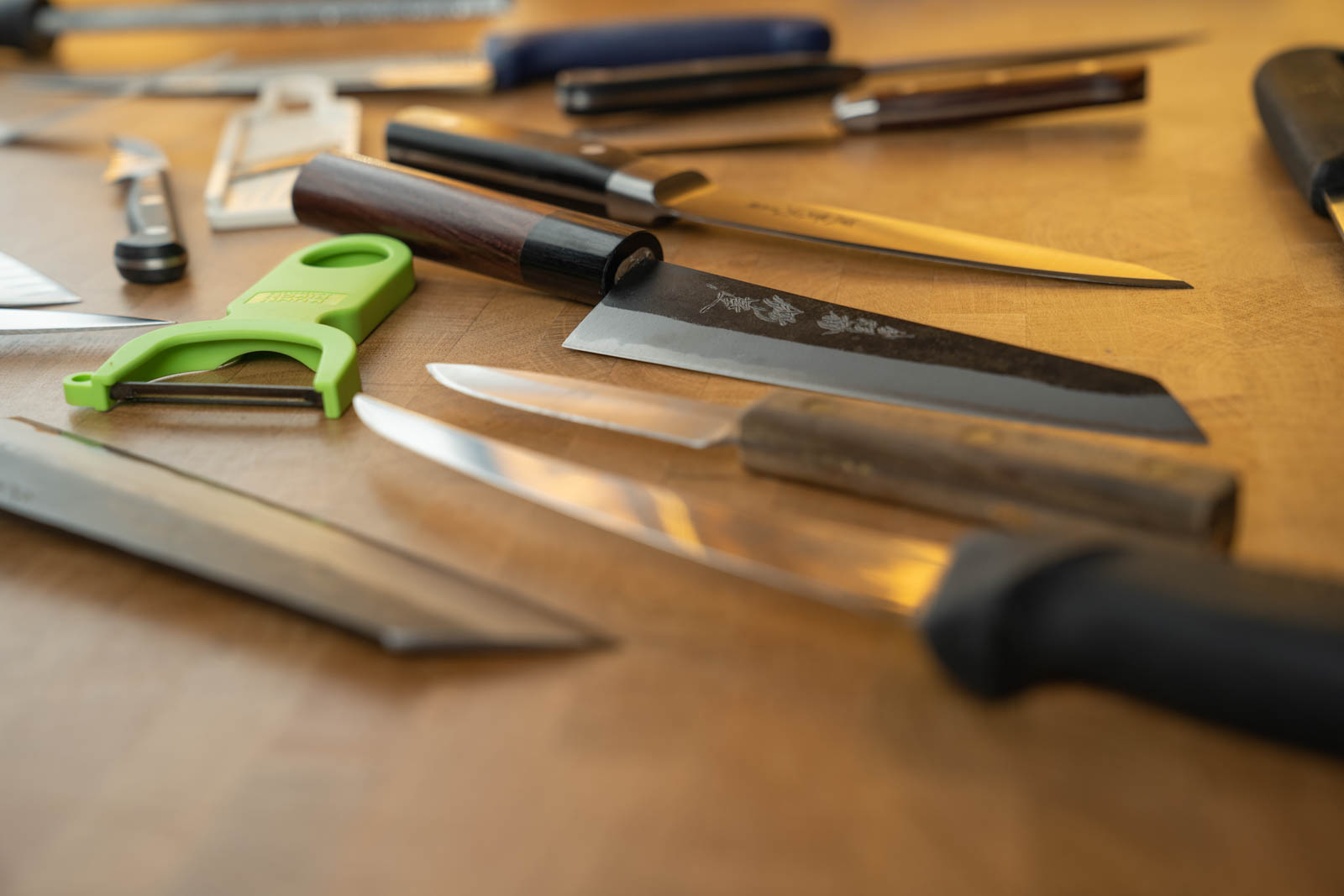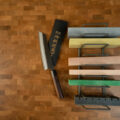I get asked which knife people should get all the time. I really do find this a difficult question as knives are a very personal kitchen tool. Both the shape and the material of the blade and handle can impact your cutting experience and when fatigue will start to come in. How you hold a knife and how you cut will also determine which knife is best for you.
Where to Get the Best Knives
I know not many will have the opportunity to shop for a knife in Japan as I did, but if you’re in Osaka check out Tower Knives and Jikko. Jikko has a few locations: a couple located in the heart of the city and their home base is located in Sakai City, which is only a short train ride away and known for making high quality Japanese cutlery. I highly recommend visiting as there are also a few other knife shops. If you find yourself in Tokyo, the Kappabashi area which is famous for having a lot of kitchenware shops. Start at Korin Knives and Tsubaya, where I finally found my honesuki (boning knife).
Here in the Bay Area, we have Bernal Cutlery in San Francisco and Perfect Edge in San Mateo. Both are great places to check knives out and even get your knives sharpened. Wherever you are, I highly encourage you to go out to your local knife shop and see if you can try, feel, and test knives out.
I don’t want to leave you with a, “Hey, don’t get a knife online. Instead go to Japan and get a knife!”. That is just rude if I did that, but no really, go to Japan and get a knife if you can! I do want to give you information to prepare you the next time you go knife shopping. The main thing is to avoid knife sets. Generally, it’s a collection of okay-at-best knives for what you think is a bargain but it isn’t. I really think that money would be better going to 1 or 2 knives from the list below and building out your own collection from that.

How to Build Your Knife Set
Good knives will always be an investment, but it is understandable that you may not want to invest or take a leap into expensive specialty knives just yet. If you just want something simple to do the job I would start looking into the following brands; Shun, Wusthof, J.A. Henkel, Global, Forschner, and Victorinox. I have used chef knives from these brands throughout my career and some I have used since culinary school 15 years ago!
European knives are known to be incredibly durable, but may need some love in the sharpness department. Japanese knives on the other hand, tend to be more fragile than European style knives but keep their sharp edge for much longer. If you are willing to build out a set, let’s go over things to look for when choosing.
Before you start, you need to ask yourself, “What kinds of things you are going to be cutting – mostly meats, more veggies, or a little of both? Do you need something for smaller fancy cuts?” Answering those questions will give you a good idea of what knife you need to look for. Here are the 3 knives that one should look into first.
Find Your Ultimate Workhorse
First up, a 7-10 inch chef’s knife is what you want to build around. A chef’s knife is a knife you’re going to use for pretty much everything so it needs to be comfortable and durable. These knives include the gyuto, santoku, nikiri, or a common European chef’s knife. Essentially, some do better with a certain style of cutting and generally, the blade shape will tell you what kind of cut its made for. Those with a more curved shape are good if you tend to rock slice or rock chop while those with flatter blade profiles do well with push and pull slicing.
Another point to consider when choosing a chef knife is the length. Some prefer a very long knife as it can tackle really hefty jobs like harder vegetables. I prefer more on the middle length to shorter length chef’s knives as it’s easier to control and maneuver.
Next to consider is the material the knife is made of. Without getting into crazy detail, if you want something easy to maintain and not worry about rusting, then stainless steel will be your best friend. If you do want to step into the world of carbon knives, they are extremely sharp and keep their edge much longer than stainless steel. My favorite is the aogami super carbon for its sharpness and edge retention. There are different levels of carbon steel knives and we can cover that on a later post but simply, if you can take care of cast iron pan, then you can take care of a carbon knife. Carbon isn’t the only steel for a ridiculous sharp knife though, there are a lot of stainless steel knife variations that are pretty darn close to the sharpness of carbon.
Where choosing a gets personal is the handle, there are Japanese style and Western style handles. The majority of my career I have used a Western style handles but do find most to be very back or handle heavy. Japanese handles are usually made of wood and lighter. They consist of the common octagonal handle or the D-shape which are mostly made for right handers but there are left handed D-shape handles. With Japanese handles you can change them out if needed, in case some sort of crack or damage has been done to the wood. I tend to find most Japanese handled knives to be well balanced or slightly front heavy promoting the sharp blade to do the majority of the work.
Your Second Best Friend
The next knife that I think would be an important second is the petty or paring knife. A petty is basically the little baby brother or sister of your chef’s knife and typically has a longer blade than a paring knife. Both can do pretty much the same job and excel with ingredients a chef’s knife might feel way too big to cut with, like certain smaller fruits and vegetables. I use my petty knife just as much as my gyotu and find that either petty or paring knife to do great with all the little intricate or fancy cuts. The choice between the 2 would be dependent on the tasks you’re going to do, but most find the extra blade length of the petty to be very useful.
For Any Specialties
The possible 3rd knife would be either a serrated bread knife or a boning knife. 2 completely different knives, I know, but it really depends on what you find yourself doing more. If you are one of those that took up baking breads during these Covid times, then a really good bread knife would probably suit you best to cut through all those yummy sourdough breads. If you don’t find yourself cutting too much bread, then maybe a boning or butcher knife for breaking down chicken or even fish. I have mostly used European style boning knives that have a thin flexible blade that does a great job in any butchery setting but recently have moved over to the honesuki karu or garasuki type Japanese boning knife for chicken and medium sized meats and have a honesuki maru type knife for larger meats I break down as it allows me to change to a “murder grip” with ease.
Those are the 3 or 4 knives I would start to look at when building out my own personal collection of kitchen knives. Again, I encourage you to go out to your local knife shop to check out some knives and try to avoid buying online because some website says so and so is the best knife period. A knife is a personal tool and it’s something you will be using (hopefully) for the rest of your life and can even pass it down generations in your family, so it’s worth the time and effort. We hope this introductory guide to finding the perfect kitchen knives was helpful. We would love to hear some of the knives you enjoy using and ones that you have your eye on as well, so let us know in the comments below!





